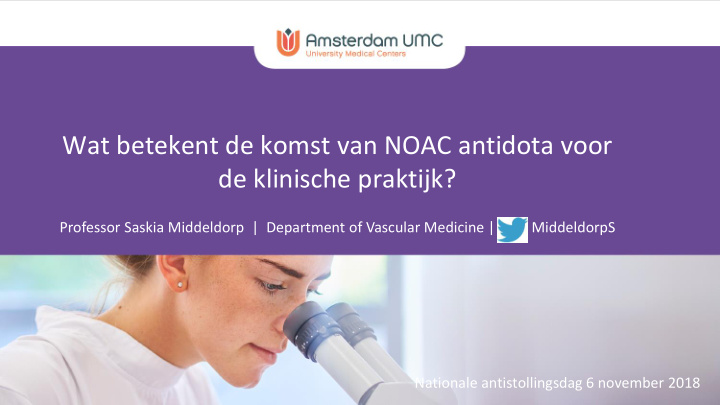



Wat betekent de komst van NOAC antidota voor de klinische praktijk? Professor Saskia Middeldorp | Department of Vascular Medicine | MiddeldorpS Nationale antistollingsdag 6 november 2018
Disclosures Research Support, Advisory Boards and Lecture Fees Aspen Bayer BMS/Pfizer Boehringer Ingelheim Daiichi Sankyo GSK Portola Sanquin Sanofi
Evidence for antidotes Surrogate Clinical endpoint endpoint To c orrect INR To improve outcome What we have What we need…
Hemostatic efficacy – The New Benchmark Effective/Good Ineffective/ Poor
VKA 30 d Thromboembolism 8%
Vitamin K antagonist related bleeding and PCC • Retrospective cohort study in 5 Dutch hospitals • 41% ICH; 36% GI • Hemostatic efficacy: 68% • Thromboembolic rate 5% • Death 22%, 60% bleeding-related Brekelmans, RPTH 2017
DOAC antidota Dabigatran: Idarucizumab (Praxbind) • Humanized antibody • 300x binding to dabigatran than dabigatran with thrombin • single bolus of 2 x 2.5 gram i.v. • Registered in 2015, available in most hospitals now SPC Praxbind; www.ema.europe.eu
RE-VERSE-AD Diluted thrombin time N= 90 130 Mortality 20% 120 110 100 Acute bleeding n=51 90 Idarucizumab 11.4 u until cessation of dTT (s) 2x 2.5 g 80 bleeding 70 60 Acute surgery n=39 50 Assay upper 92% normalization of 40 limit of normal 30 coagulation 20 10 – 30 Baseline Between 1h 2h 4h 12h 24h vials min Time post idarucizumab Pollack, N Eng J Med 2015/ Full cohort analysis NEJM 2017
DOAC antidota Factor Xa inhibitors: Andexanet alfa Catalytic domain Gla domein Siegal, N Eng J Med 2015
Andexanet alfa – not yet on the market Anti-Xa activity decrease: 89% (58 – 94%) Connolly NEJM 2017
Hemostatic Efficacy with Andexanet • Excellent or good in 79% (95%CI 64-89) Connolly NEJM 2017
Andexanet alfa – almost on the market in NL? Siegal NEJM 2015
PCC in rivaroxaban treated healthy volunteers 50 IU/kg 50 IU/kg Surrogate Clinical endpoint endpoint???? To c orrect INR
Factor Xa inhibitor and Prothrombin complex concentrate (PCC) apixaban Eerenberg, Circulation 2011 Cheung, J Thromb Haemost 2015
Recent Regulatory Trials of Reversal Agents Thrombotic Hemostatic Efficacy Mortality Number Event Rate (95CI) (95CI) Pivotal Reversal agent (95 CI) Study Anti-coagulant Total % ICH Total ICH Total ICH Total ICH Andexanet 85% 83% 11% 10% 11% 10% ANNEXA-4 227 61 FXa Inhibitors (77-90) (72-91) (7-16) (5-18) (7-16) (5-18) REVERSE- Idarucizumab 5% 6% 5% 6% 301 33 68% a NR b AD Dabigatran (3-8) (2-13) (3-8) (2-13) Sarode 4F-PCC 72% 42% 8% 8% 98 12 NR NR 2013 Warfarin (64-81) (15-72) (3-15) (3-15) Sarode Plasma 65% 58% 6% 6% 4F-PCC = Four factor prothrombin complex concentrate; ICH = Intracranial hemorrhage; NR = Not reported 104 12 NR NR 2013 Warfarin (56-75) (28-85) (3-13) (3-13) a 68% had investigator-determined, non-adjudicated time to hemostasis within 24 hours b Time to hemostasis not calculated in ICH patients
EHRA 2013 practice guidelines idarucizumab Heidbuchel, Europace 2013
Reversal for DOAC in urgent surgery How important is this? Peri-procedural bleeds in RE-LY (dabigatran) No difference with warfarin despite the absence of a specific antidote Urgent surgery VKA Dabigatran 110 mg Dabigatran 150 mg N=111 bid bid N=107 N=141 % Major bleeds 21.6 17.8 17.7 RR (95%CI) vs VKA 1 0.82 (0.48-1.41) 0.82 (0.50-1.35) Healey, Circulation 2012
Clinical scenario’s The bleeding patient The patient undergoing urgent surgery The patient on DOAC with ischemic stroke Does having an antidote influence the choice of anticoagulant drug?
• AMC • MUMC+ • Erasmus MC • Albert Schweitzer Ziekenhuis • UMCG.
Use of idarucizumab January – August 2016 Kermer, Int J Stroke 2017
Retrospective cohort study 19 patients with ischemic stroke • 18 < 4,5 hrs after onset • 1 wake up stroke R/ idarucizumab + r-tPA 79% benefit of thrombolysis Kermer, Int J Stroke 2017
Retrospective cohort study 12 patients with intracranial bleeding • 2 patients with hematoma growth R/ idarucizumab 67% favourable outcome TE events: 1 fatal pulmonary embolism after 5 days Kermer, Int J Stroke 2017
Dutch experience First 2 years after release in January 2016 12 centers 86 patients • 51 severe bleeding (20 GI, 18 intracranial) • 34 urgent surgery • Mortality in 90 days 20% • ? Effective hemostasis in 16 (31%) bleeding patients • ? Large proportion of inappropriate use Van der Wall, Eur Heart J abstract 2018
What about andexanet? • Full cohort results expected early 2019 • Phase 4 RCT with standard of care comparison in patients with intracranial hemorrhage required by FDA • Surgery intervention not studied • Very high costs … Andexa FDA approval Letter May 3, 2018
In a bleeding patient, ask the right questions 1. What anticoagulant is prescribed? 2. Is anticoagulant present at high quantity? • When was last dose taken? • Half-life and renal function, (age, weight)? 3. Site and severity of bleed? • Local measures? • Is reversal necessary?
Antidotes … . • First, they were not there • Controversy regarding the need • Now that we have them, we need them …
Take home messages • The choice of an antidote may drive the choice for an anticoagulant, particularly in patients at high risk of bleeding • Idarucizumab is easy to administer and widely available • Andexanet is complicated and not yet available • Guidance for stringent use needed
Recommend
More recommend